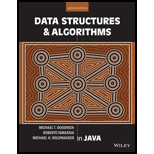
Explanation of Solution
Output of the code:
Create a main class Maryland that extends the State class and it includes printMe() to display the respective header in console.
// Create a class Maryland
public class Maryland extends State
{
// Null constructor
Maryland( )
{
}
// Create a method
public void printMe( )
{
System.out.println("Read it.");
}
Create a main() function and create the objects for the class using new keyword and call the method printMe() to display the respective header.
// Main function
public static void main(String[ ] args)
{
// Create the objects for classes
Region east = new State( );
State md = new Maryland( );
Object obj = new Place( );
Place usa = new Region( );
/* Call the method printMe() using state class object.*/
md.printMe( );
// Call the method printMe() using object
east.printMe( );
// Call the method printMe() in Place class
((Place) obj).printMe( );
//Assign the state class object to object class
obj = md;
// Call the method printMe() in maryland class
((Maryland) obj).printMe( );
//Assign the place class object to object class
obj = usa;
// Call the method printMe() in place class
((Place) obj).printMe( );
//Assign the state class object to place class
usa = md;
// Call the method printMe() in place class
((Place) usa).printMe( );
}
}
Create a class State that extends the class Region and includes a method printMe() to display the header.
// Create a class that extends the Region
class State extends Region
{
//Null constructor
State( )
{
}
//Create a method
public void printMe( )
{
//Display the header
System.out.println("Ship it.");
}
}
Create a class Region that extends the class Place and includes a method printMe() to display the header...
Want to see the full answer?
Check out a sample textbook solution
Chapter 2 Solutions
Data Structures and Algorithms in Java
 EBK JAVA PROGRAMMINGComputer ScienceISBN:9781337671385Author:FARRELLPublisher:CENGAGE LEARNING - CONSIGNMENT
EBK JAVA PROGRAMMINGComputer ScienceISBN:9781337671385Author:FARRELLPublisher:CENGAGE LEARNING - CONSIGNMENT Microsoft Visual C#Computer ScienceISBN:9781337102100Author:Joyce, Farrell.Publisher:Cengage Learning,
Microsoft Visual C#Computer ScienceISBN:9781337102100Author:Joyce, Farrell.Publisher:Cengage Learning, C++ Programming: From Problem Analysis to Program...Computer ScienceISBN:9781337102087Author:D. S. MalikPublisher:Cengage Learning
C++ Programming: From Problem Analysis to Program...Computer ScienceISBN:9781337102087Author:D. S. MalikPublisher:Cengage Learning C++ for Engineers and ScientistsComputer ScienceISBN:9781133187844Author:Bronson, Gary J.Publisher:Course Technology PtrProgramming Logic & Design ComprehensiveComputer ScienceISBN:9781337669405Author:FARRELLPublisher:Cengage
C++ for Engineers and ScientistsComputer ScienceISBN:9781133187844Author:Bronson, Gary J.Publisher:Course Technology PtrProgramming Logic & Design ComprehensiveComputer ScienceISBN:9781337669405Author:FARRELLPublisher:Cengage Systems ArchitectureComputer ScienceISBN:9781305080195Author:Stephen D. BurdPublisher:Cengage Learning
Systems ArchitectureComputer ScienceISBN:9781305080195Author:Stephen D. BurdPublisher:Cengage Learning





